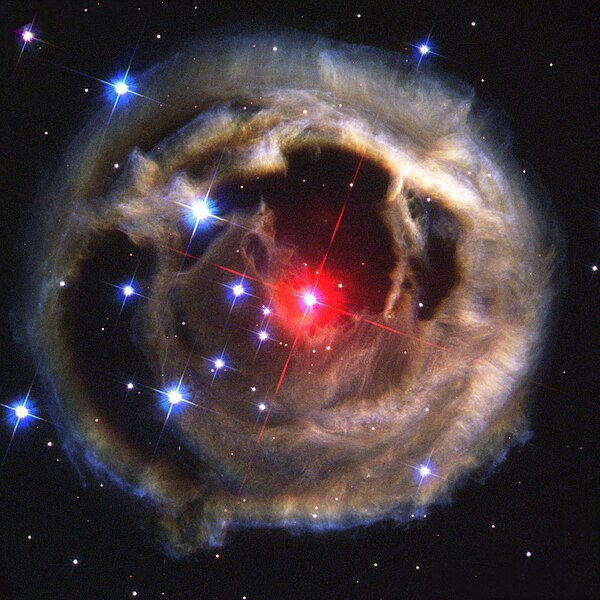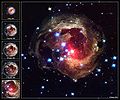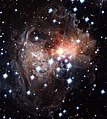File:V838 Mon HST.jpg

Original file (1,651 × 1,651 pixels, file size: 276 KB, MIME type: image/jpeg)
| This is a file from the Wikimedia Commons. The description on its description page there is shown below.
|
Summary
| DescriptionV838 Mon HST.jpg |
العربية: الضوء يصدح حول V838 وحيد القرن
خلال شهر كانون الثاني (يناير) 2002، انقلب حالُ نجمٍ كامدٍ في كوكبةٍ غامضةٍ رأسًا على عقب، فأصبح أكثر إنارةً بِحوالي 600,000 مرَّة من الشمس، ممَّا جعله ألمع نُجُوم مجرَّة درب التبَّانة، لِفترةٍ من الزمن. هذا النجمُ الغامض، المُسمَّى V838 وحيد القرن، سُرعان ما عاد واختفى في غياهب الظُلُمات. لكنَّ رُصُود مقراب هابل الفضائي التابع لِوكالة ناسا لِظاهرةٍ تُسمَّى «صدى الضوء» وقعت حول هذا النجم كشفت النقاب عن العديد من الميزات المُذهلة. من شأن هذه البيانات أن تُزوِّد عُلماء الفلك بِصُورٍ مسباريَّة شبيهة بِالصُور المقطعيَّة المُحوسبة لِلبُنية ثُلاثيَّة الأبعاد لِقُشُور الغُبار المُحيطة بِالنُجُوم الكهلة. English: Light echo around V838 Monocerotis
In January 2002, a dull star in an obscure constellation suddenly became 600,000 times more luminous than our Sun, temporarily making it the brightest star in our Milky Way galaxy. The mysterious star, called V838 Monocerotis, has long since faded back to obscurity. But observations by NASA's Hubble Space Telescope of a phenomenon called a "light echo" around the star have uncovered remarkable new features. These details promise to provide astronomers with a CAT-scan-like probe of the three-dimensional structure of shells of dust surrounding an aging star. Español: Luz eco alrededor de V838 Monocerotis
En enero de 2002, una estrella sin brillo en una constelación oscura de repente se convirtió en 600.000 veces más luminosa que nuestro Sol, por lo que temporalmente la estrella más brillante de nuestra galaxia, la Vía Láctea. La estrella misteriosa, llamada V838 Monocerotis, desde hace mucho tiempo se ha desvanecido de nuevo a la oscuridad. Pero las observaciones por el telescopio espacial de un fenómeno de Hubble de la NASA llamado "eco de luz" alrededor de la estrella han destapado nuevas características notables. Estos detalles promesa de proporcionar a los astrónomos con una sonda CAT-scan-como de la estructura tridimensional de las cáscaras de polvo que rodean una vieja estrella. Français : Aura de lumière autour de V838 Monocerotis
Courant janvier 2002, l'étoile V838 de la Licorne (en rouge, au centre) devint brusquement 60 000 fois plus brillante que le Soleil, ce qui fit d'elle l'étoile temporairement la plus brillante de notre Voie Lactée. Dans les mois suivant, ce flash cosmique, un phénomène d'"écho lumineux", devint observable sous la forme d'anneaux concentriques autour de l'étoile. Ce phénomène permet d'etudier la structure des nuages de poussière entourant cette étoile en fin de vie. 한국어: Light echo around V838 Monocerotis
2002년 1월 외뿔소자리 V838은 짧은 기간 동안 태양의 60만 배로 밝아졌으며 잠시나마 우리 은하에서 가장 밝은 별의 지위를 누렸다. 이후 이 별은 서서히 어두워져서 시야에서 사라져 갔다. 미국 항공우주국 허블 우주 망원경은 이 별 주위에 '빛의 메아리'로 명명된, 주목할만한 구조가 형성되어 있음을 포착했다. Português: Eco luminoso em torno do V838 Monocerotis Em janeiro de 2002, uma estrela sem graça em uma obscura constelação de repente tornou-se 600.000 vezes mais luminosa que o Sol, tornando-se temporariamente a estrela mais brilhante em nossa galáxia Via Láctea. A estrela misteriosa, chamada V838 Monocerotis, já há muito desapareceu de volta à obscuridade. Mas observações feitas pelo Telescópio Espacial Hubble, da NASA, de um fenômeno chamado "eco de luz" em torno da estrela revelou extraordinárias novas funcionalidades.Estes detalhes prometem fornecer aos astrônomos com uma sonda CAT-scan-like a sondagem das estruturas tridimensionais de conchas de poeira em torno de uma estrela em envelhecimento. |
| Date | |
| Source | |
| Author | NASA, ESA and H.E. Bond (STScI) |
| Permission (Reusing this file) |
|
| Other versions |
|
Licensing
| Public domainPublic domainfalsefalse |
This file is in the public domain because it was created by NASA and ESA. NASA Hubble material (and ESA Hubble material prior to 2009) is copyright-free and may be freely used as in the public domain without fee, on the condition that only NASA, STScI, and/or ESA is credited as the source of the material. This license does not apply if ESA material created after 2008 or source material from other organizations is in use.
The material was created for NASA by Space Telescope Science Institute under Contract NAS5-26555, or for ESA by the Hubble European Space Agency Information Centre. Copyright statement at hubblesite.org or 2008 copyright statement at spacetelescope.org. For material created by the European Space Agency on the spacetelescope.org site since 2009, use the {{ESA-Hubble}} tag. |
|

|
This image was selected as picture of the day on Wikimedia Commons for 28 January 2005. It was captioned as follows: English: "Light echo" around V838 Monocerotis becoming 600,000 times more luminous than our sun in January 2002 Other languages:
Čeština: „Světelné echo“ kolem hvězdy V838 Monocerotis, která se v lednu 2002 dočasně stala 600 000krát svítivější než Slunce. English: "Light echo" around V838 Monocerotis becoming 600,000 times more luminous than our sun in January 2002 Español: Aura luminosa en torno a V838 Monocerotis convirtiéndose en 60.000 veces más luminosa que el Sol en enero de 2002 Esperanto: "Lumo eĥo" ĉirkaŭ V838 Monocerotis fariĝ 600,000 ..oble pli luma ol nia suno en Januaro 2002 Français : Aura de lumière autour de V838 Monocerotis devenant 600 000 fois plus lumineuse que le soleil. Janvier 2002. Italiano: "aura luminosa" attorno V838 Monocerotis che divenne 600.000 volte più luminoso del sole, scattata nel gennaio 2002. Nederlands: "Lichtecho" rond de ster V838 Monocerotis die in januari 2002 een luminositeit had van 600.000 maal onze zon Polski: "Świetlne echo" wokół gwiazdy V838 Monocerotis stającej się 600 000 razy jaśniejsza od Słońca w styczniu 2002 Português: "Eco luminoso" em torno do V838 Monocerotis tornando-se 600.000 vezes mais luminoso que nosso Sol em janeiro de 2002 Русский: "световое эхо" вокруг V838 Единорога, ставшая в 600,000 тысяч раз более яркой чем наше Солнце в январе 2002 日本語: 2002年1月、太陽の約60万倍の光を発した麒麟座にあるV848の超新星爆発。 中文: 2002年1月麒麟座V848超新星爆发,相当太阳光强度的60万倍 |
Captions
Items portrayed in this file
depicts
17 December 2002
No value exists for this property
File history
Click on a date/time to view the file as it appeared at that time.
| Date/Time | Dimensions | User | Comment | |
|---|---|---|---|---|
| current | 22:18, 20 December 2004 | 1,651 × 1,651 (276 KB) | Evil Monkey | In January 2002, a dull star in an obscure constellation suddenly became 600,000 times more luminous than our Sun, temporarily making it the brightest star in our Milky Way galaxy. The mysterious star, called V838 Monocerotis, has long since faded back to |
File usage
The following 3 pages use this file:
Metadata
This file contains additional information, probably added from the digital camera or scanner used to create or digitize it.
If the file has been modified from its original state, some details may not fully reflect the modified file.
| Orientation | Normal |
|---|---|
| Horizontal resolution | 100 dpi |
| Vertical resolution | 100 dpi |
| Software used | Adobe Photoshop 7.0 |
| File change date and time | 14:17, 14 March 2003 |
| Color space | Uncalibrated |
| IIM version | 2 |





